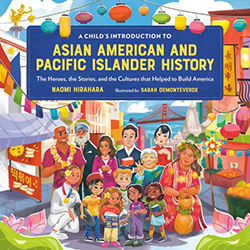
A CHILD’S INTRODUCTION TO ASIAN AMERICAN AND PACIFIC ISLANDER HISTORY
Black Dog and Leventhal
April 2024
The perfect primer for kids ages 8-12, A Child’s Introduction to Asian American and Pacific Islander History, written by Naomi Hirahara and illustrated by Sarah Demonteverde, is packed with remarkable stories, groundbreaking events, and inspirational people, that have made a lasting impact on the history and culture of the United States.
The latest entry in the award-winning Child’s Introduction series is an inspirational and essential look at the impact and influence that AAPI peoples have made to the culture of the United States. The book is packed with profiles of dozens of AAPI trailblazers from from all walks of life, including political activist Grace Lee Boggs, Vice President Kamala Harris, actor Dwayne “The Rock” Johnson, and dozens of others who have made contributions to music, food, sciences, technology, and more. Kids will learn key terms like “Asian American” and “Pacific Islander,” how to pronounce common Asian names, and the discrimination members of the community have faced (and continue to face). They will be introduced to a wide variety of traditions, from Diwali to Lunar New Year and signature dishes, like poi and pho, all giving greater visibility to Asian Americans for young learners.
Featuring charming illustrations and a lively design, as well as a pull-out poster, A Child’s Introduction to Asian American and Pacific Islander History is much-needed addition every home library and classroom.
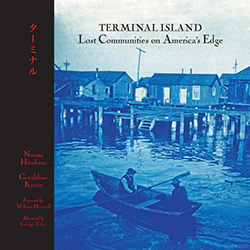
TERMINAL ISLAND: LOST COMMUNITIES ON AMERICA’S EDGE
Angel City Press and the Port of Los Angeles
January 2015; reissued as a hardback March 2024 with an afterword by George Takei
Terminal lsland: Lost Communities on America’s Edge tells a story of the birth, flourishing, and ultimate destruction of Terminal Island, a vibrant community in Los Angeles Harbor. Written by Naomi Hirahara and Geraldine Knatz, with a foreword by William Deverell and an afterword by George Takei, this insightful work uncovers the untold story of a forgotten chapter in American history—the rise and fall of a vibrant community on Terminal Island in Los Angeles Harbor that was ultimately destroyed during World War II.
Few Los Angelenos have visited Terminal Island, a sheltered spot in the Pacific Ocean that once served as a resort for wealthy Southern California landowners and as a refuge for its artists and writers and scientists, all in need of a respite from the heat of the city. Not long after the rich and creative were driven away by a greedy throng of industrialists and railroad magnates and the politics they wrought, Terminal Island became home to another thriving world, this time a small community of Japanese families, people linked by their lineage and their amazing ability to capture the biggest fish the Pacific had to offer. They were the fishermen of Terminal Island. And their wives. And their children. These people were at the heart of one of Southern California’s most important businesses: the fisheries.
And then came a war. A world war that devastated the hopes, dreams, homes, and families of the Japanese who lived on Terminal Island. The Japanese and Japanese American residents of the island were forced from their homes and sent to internment camps around the country. The island became, in the truest, deepest sense, a ghost town.
With more than 230 rare archival images, Terminal Island tells the story of this beloved place through its various incarnations, ending with its ultimate destruction at the hands of the US government. An Afterword by renowned actor and Japanese American activist George Takei reminds readers of the humanity of all those who have inhabited Terminal Island, and the tragic decision to remove people who had built their lives there. Terminal Island tells an American story that is social, political, and also deeply personal.
- Bruckman Award for Excellence in a Book about Los Angeles from the Los Angeles Public Library
- Award of Merit for Scholar/Authorship from the Conference of California Historical Societies
- Third place for the national “Best Book” Award by Westerners International
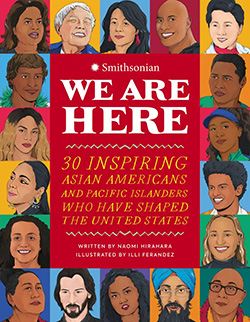
WE ARE HERE: 30 INSPIRING ASIAN AMERICANS AND PACIFIC ISLANDERS WHO HAVE SHAPED THE UNITED STATES
Smithsonian Institution with Running Kids Press
October 2022
A stunning anthology licensed in partnership with the Smithsonian Asian Pacific American Center, We Are Here celebrates 30 of the most inspiring Asian Americans and Pacific Islanders in U.S. history.
There are more than 23 million people of Asian and Pacific Islander descent living in the United States. Their stories span across generations, as well as across the world. We Are Here highlights thirty Asian Americans and Pacific Islanders and the impact they’ve had on the cultural, social, and political fabric of the United States.
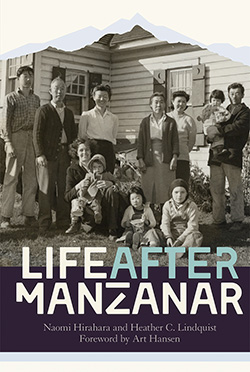
LIFE AFTER MANZANAR
Heyday with Manzanar History Association
April 2018
From the editor of the award-winning Children of Manzanar, Heather C. Lindquist, and Edgar Award winner Naomi Hirahara comes a nuanced account of the “Resettlement”: the relatively unexamined period when ordinary people of Japanese ancestry, having been unjustly imprisoned during World War II, were finally released from custody. Given twenty-five dollars and a one-way bus ticket to make a new life, some ventured east to Denver and Chicago to start over, while others returned to Southern California only to face discrimination and an alarming scarcity of housing and jobs.
Hirahara and Lindquist weave new and archival oral histories into an engaging narrative that illuminates the lives of former internees in the postwar era, both in struggle and unlikely triumph. Readers will appreciate the painstaking efforts that rebuilding required, and will feel inspired by the activism that led to redress and restitution—and that built a community that even now speaks out against other racist agendas.
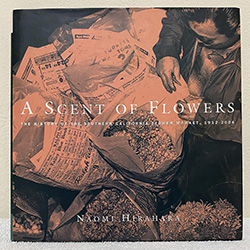
A SCENT OF FLOWERS: THE HISTORY OF THE SOUTHERN CALIFORNIA FLOWER MARKET, 1912-2004
Midori Books
2004
A Scent of Flowers traces the century-long contributions of Japanese Americans and other ethnic Americans to the Southern California floricultural industry. Where there are now schools, shopping centers, and freeways were once acres of flowers, ranging from sweet peas and daisies to chrysanthemums and carnations. The Southern California Flower Market, founded by Japanese immigrants in 1912, was the first centralized center for flower sales in the region. Enter this vibrant world through the stories and photographs of these hard-working families. Through their experiences, readers will get a sense of how Southern California and its people have evolved from when the land was filled with fields of food and flowers.
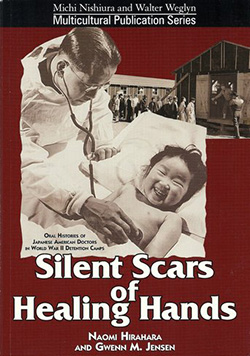
SILENT SCARS OF HEALING HANDS: ORAL HISTORIES OF JAPANESE AMERICAN DOCTORS IN WORLD WAR II DETENTION CAMPS
By Naomi Hirahara and Gwenn M. Jensen
Center for Oral and Public History California December 2004
This book opens the door to the lives of the Japanese Americans who practiced medicine under the most stressful conditions: within the confines of detention centers in their own country during World War II. These excerpts from original oral histories, collected by a special team organized by the Japanese American Medical Association, tell the story of men and women who depended on ingenuity and compassion to care for their patients in makeshift hospitals in remote areas of the United States.
Proceeds from the sale of Silent Scars of Healing Hands benefit the Japanese American Medical Association Scholarship Fund.
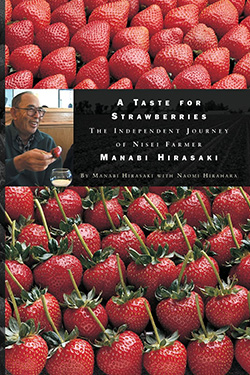
A TASTE FOR STRAWBERRIES: THE INDEPENDENT JOURNEY OF NISEI FARMER MANABI HIRASAKI
By Manabi Hirasaki with Naomi Hirahara
Japanese American National Museum
November 2003
A young boy running through the garlic fields of Gilroy, California. A Japanese American on the battlefields of World War II Europe. A thirty-something man staking out new land for a farming venture that would change his life. Manabi Hirasaki, the son of a successful California farmer, lived this Nisei experience in his own way and on his own terms.
A Taste For Strawberries vividly recounts one man’s enduring relationship with the world of strawberries and his rise to become the first non-European American board member of Driscoll Strawberry Associates, the world’s largest commercial strawberry distributor. A 522nd Field Artillery Battalion veteran, savvy entrepreneur, and generous philanthropist, the story of Mr. Hirasaki’s life is sure to touch readers with its spirit and humor. A Taste For Strawberries is the second in the American Profiles series of biographies published by the Japanese American National Museum.
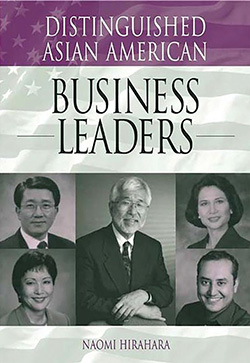
DISTINGUISHED ASIAN AMERICAN BUSINESS LEADERS
Greenwood Press
March 2003
Although there are other reference books about Asian Americans, no other book focuses solely on businesspeople. This collection of engagingly written biographies gives the details on the lives of 96 Asian men and women who have had successful business careers, giving information on their education, training, and career highlights and histories.
The book provides valuable information as well as inspiration to students, from high school through university.
Each biography concludes with references for further reading, and an appendix lists the people profiled by field of business, from fashion to restaurant franchises, from high technology to the movie industry.
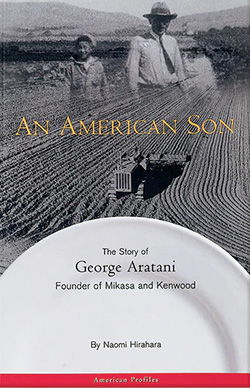
AN AMERICAN SON: THE STORY OF GEORGE ARATANI, FOUNDER OF MIKASA AND KENWOOD
Japanese American National Museum
May 2001
Decades before trade moved between the United States and Japan at its present pace, there was a Japanese immigrant’s son with an American dream. Born to a farming tycoon in California, George Aratani was forced to leave the family business behind when incarcerated with over 100,000 Japanese Americans during World War II. After the war, he traveled to Japan with little idea of what he would import from the war-devastated archipelago. What followed was the development of two powerful businesses, Mikasa and Kenwood.
The story of the many who founded these companies not only reflects the economic rebuildling of Japan, but also the struggle of Japanese Americans to make significant contributions to American history. First in the American Profiles series published by the Japanese American National Museum.
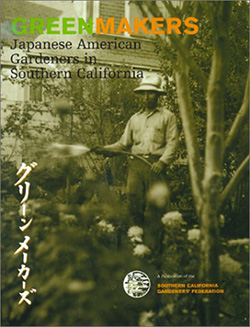
GREEN MAKERS: JAPANESE AMERICAN GARDENERS IN SOUTHERN CALIFORNIA
California Gardeners’ Federation
December 2000
Green Makers explores the little-known history of an enterprising group of men and women. Learn how Japanese American gardeners transformed the Southern California landscape for more than a century. Equipped with only pick-up trucks and lawnmowers, they faced discriminatory laws and even the forced removal from their homes during WWII. Yet they remained committed to their goal: to make Southern California green for their families, ethnic communities, and region.
This volume includes original writings, photographs, historic summaries, and a timeline spanning a hundred years. Written in both English and Japanese. B/W photos.